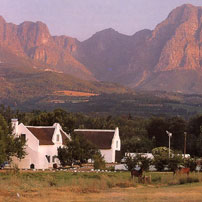 For most people, when they are thinking about a first trip to South Africa there is almost a wish list of places to visit and things to see to do; take in the views from the of Table Mountain, visit the famous wineries of Franschhoek and Stellenbosch, explore the scenic splendours of the Garden Route and of course go on safari. Such is the beauty and diversity of South Africa however that it often calls people back for a return visit, but where is next on the list? KwaZulu Natal is certainly an option with long coastlines, the colossal and dramatic Drakensberg mountains, Zulu culture and both Boer and Anglo Zulu battlefields history, but where else? I have recently returned from a trip to the Cape Winelands, west coast beaches and Cederberg mountains which encompassed an equal number of experiences in beautiful and contrasting landscapes. As an added bonus, all these areas are found within an easy drive of no more than three and a half hours from the Mother City, Cape Town. On first sight the Cape Winelands may not offer the same level of sophistication as the established destinations of Franschhoek and Stellenbosch but for me this region of verdant valleys, quirky towns and Cape Dutch farmsteads showcase a more authentic and historical side to South Africa. From my arrival in Cape Town I drove up to Wellington, a lovely little town tucked away in a beautifiul valley between the Berg River and the majestic Hawequas mountains. Of all the pioneers, more French remained in the valley than any other nationality which, along with fertile soils, explains the areas long history of winemaking. It’s importance today is immense with 90% of the countries vines being grown in local nurseries before being sent on to the many vineyards for planting.
For most people, when they are thinking about a first trip to South Africa there is almost a wish list of places to visit and things to see to do; take in the views from the of Table Mountain, visit the famous wineries of Franschhoek and Stellenbosch, explore the scenic splendours of the Garden Route and of course go on safari. Such is the beauty and diversity of South Africa however that it often calls people back for a return visit, but where is next on the list? KwaZulu Natal is certainly an option with long coastlines, the colossal and dramatic Drakensberg mountains, Zulu culture and both Boer and Anglo Zulu battlefields history, but where else? I have recently returned from a trip to the Cape Winelands, west coast beaches and Cederberg mountains which encompassed an equal number of experiences in beautiful and contrasting landscapes. As an added bonus, all these areas are found within an easy drive of no more than three and a half hours from the Mother City, Cape Town. On first sight the Cape Winelands may not offer the same level of sophistication as the established destinations of Franschhoek and Stellenbosch but for me this region of verdant valleys, quirky towns and Cape Dutch farmsteads showcase a more authentic and historical side to South Africa. From my arrival in Cape Town I drove up to Wellington, a lovely little town tucked away in a beautifiul valley between the Berg River and the majestic Hawequas mountains. Of all the pioneers, more French remained in the valley than any other nationality which, along with fertile soils, explains the areas long history of winemaking. It’s importance today is immense with 90% of the countries vines being grown in local nurseries before being sent on to the many vineyards for planting.
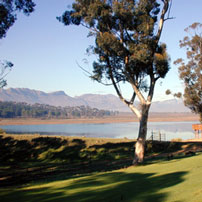 In spite of this heritage of winemaking the area was actually very late in terms of developing a tourist industry around it. Today however there is an easily combined network of boutique wineries and fruit farms, all offering tours. Just north of Wellington, I arrived at Bartholomeus Klip, a working sheep and wheat farm set in the heart of the Riebeck Valley. A stay here is about far more than just the lovely Victorian-style homestead accommodation, the excellent cuisine for which the farm has become renowned and the delightful staff, most of whose families have worked on the same farm land for hundreds of years. The lodge can also be viewed as an excellent base for local exploration; there are some splendid mountain passes to drive allowing visits to the small heritage town of Tulbagh and the emerging wine producing town of Riebeek Kasteel. Alternatively, the farm and adjoining nature reserve have much to offer. The effects of the wonderful food can be burnt off with gentle strolls around the farm or more strenuous hiking in the mountains, mountain bikes can be borrowed for rides through the wheat fields and the fresh water dam offers plentiful opportunities for canoeing, windsurfing, fishing and swimming. The farm itself is also an attraction, particularly during lambing and shearing when guests are welcome to visit the operation.
In spite of this heritage of winemaking the area was actually very late in terms of developing a tourist industry around it. Today however there is an easily combined network of boutique wineries and fruit farms, all offering tours. Just north of Wellington, I arrived at Bartholomeus Klip, a working sheep and wheat farm set in the heart of the Riebeck Valley. A stay here is about far more than just the lovely Victorian-style homestead accommodation, the excellent cuisine for which the farm has become renowned and the delightful staff, most of whose families have worked on the same farm land for hundreds of years. The lodge can also be viewed as an excellent base for local exploration; there are some splendid mountain passes to drive allowing visits to the small heritage town of Tulbagh and the emerging wine producing town of Riebeek Kasteel. Alternatively, the farm and adjoining nature reserve have much to offer. The effects of the wonderful food can be burnt off with gentle strolls around the farm or more strenuous hiking in the mountains, mountain bikes can be borrowed for rides through the wheat fields and the fresh water dam offers plentiful opportunities for canoeing, windsurfing, fishing and swimming. The farm itself is also an attraction, particularly during lambing and shearing when guests are welcome to visit the operation. 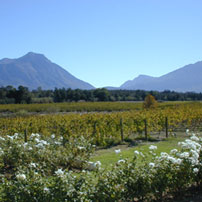 BK (as the owners affectionately call it!) is the guardian of the Elansberg Nature Reserve, an area of some 10,000 hectares with an extraordinary diversity of flowering plants. This diversity plus being a crucial conservation area for two rare fynbos vegetation types (Swartland Alluvium Fynbos and Swartland Alluvium Renosterveld) has led to the reserve being designated as a Natural Heritage Site. The nature reserve is overlooked by towering mountains and come spring will be carpeted by thousands of wildflowers. Morning and afternoon game drives will not only introduce you to the flora, but also the wildlife on the reserve. This is not a big game safari destination but you will see such species as wildebeest, eland and bontebok and if you are lucky perhaps bat-eared fox and caracal. You may not get to see the kings of an African safari like lions or elephants here but the chances are you will see some rarities. The strikingly beautiful geometric tortoise is now one of one of the rarest reptiles left in Africa and BK runs a breeding programme to guarantee its future. Perhaps more fascinating is the chance of seeing the results of a special project to reintroduce ‘quagga’ to the lands they used to roam. Closely related to the plains zebra, a quagga had a brown back and no stripes on its rump or hind legs . Sadly they were hunted to extinction by farmers in the 1800’s who viewed them as competition for good grazing for their own livestock. Through the use of DNA and selective breeding, scientists at Cape Town University are trying to reintroduce the species and guest at BK have a good chance of seeing their results in the nature reserve. Leaving the lush valleys behind me I headed west into a completely different landscape. As I drove towards the coast, I imagined it to be similar to driving through the American prairies as I passed endless wheat fields and cattle farms to reach my half way point, the lovely little farming town of Darling. There is not a
BK (as the owners affectionately call it!) is the guardian of the Elansberg Nature Reserve, an area of some 10,000 hectares with an extraordinary diversity of flowering plants. This diversity plus being a crucial conservation area for two rare fynbos vegetation types (Swartland Alluvium Fynbos and Swartland Alluvium Renosterveld) has led to the reserve being designated as a Natural Heritage Site. The nature reserve is overlooked by towering mountains and come spring will be carpeted by thousands of wildflowers. Morning and afternoon game drives will not only introduce you to the flora, but also the wildlife on the reserve. This is not a big game safari destination but you will see such species as wildebeest, eland and bontebok and if you are lucky perhaps bat-eared fox and caracal. You may not get to see the kings of an African safari like lions or elephants here but the chances are you will see some rarities. The strikingly beautiful geometric tortoise is now one of one of the rarest reptiles left in Africa and BK runs a breeding programme to guarantee its future. Perhaps more fascinating is the chance of seeing the results of a special project to reintroduce ‘quagga’ to the lands they used to roam. Closely related to the plains zebra, a quagga had a brown back and no stripes on its rump or hind legs . Sadly they were hunted to extinction by farmers in the 1800’s who viewed them as competition for good grazing for their own livestock. Through the use of DNA and selective breeding, scientists at Cape Town University are trying to reintroduce the species and guest at BK have a good chance of seeing their results in the nature reserve. Leaving the lush valleys behind me I headed west into a completely different landscape. As I drove towards the coast, I imagined it to be similar to driving through the American prairies as I passed endless wheat fields and cattle farms to reach my half way point, the lovely little farming town of Darling. There is not a 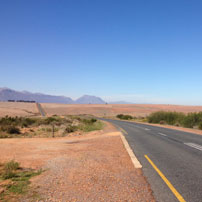 lot to Darling but it oozes charm and character. Within South Africa is most famous for being home to one of their best known satirists, Pieter-Dirk Uys, and perhaps because of that it has attracted a variety of different artists resulting in a collection of workshops, galleries and music festivals. The cultural centre will explain the local heritage of the San people who used to roam these land whilst the Darling Museum showcases the towns history of butter making! It is not a town without contrast and with delightful restaurant names such as the Flying Pig and the Marmalade Cat, it is well worth a stop! Having topped up my caffeine levels, I continued through to the West Coast National Park. Hugging the coastline some 120 Kms north of Cape Town, the park is best known for two things; flowers and birds. Each spring (August and September) the park takes on a multi coloured hue as the wild flowers burst into life and visitor numbers increase as people are drawn to just one of the parks where the wildflowers put on this annual display. The major focal point of the park is the Langebaan Lagoon, a mecca for bird enthusiasts as it is home to thousands of seabirds who roost on protected islands and in the salty marshes. March and September are particularly good times to visit as this coincides with the departure and arrival of the migrant species.
lot to Darling but it oozes charm and character. Within South Africa is most famous for being home to one of their best known satirists, Pieter-Dirk Uys, and perhaps because of that it has attracted a variety of different artists resulting in a collection of workshops, galleries and music festivals. The cultural centre will explain the local heritage of the San people who used to roam these land whilst the Darling Museum showcases the towns history of butter making! It is not a town without contrast and with delightful restaurant names such as the Flying Pig and the Marmalade Cat, it is well worth a stop! Having topped up my caffeine levels, I continued through to the West Coast National Park. Hugging the coastline some 120 Kms north of Cape Town, the park is best known for two things; flowers and birds. Each spring (August and September) the park takes on a multi coloured hue as the wild flowers burst into life and visitor numbers increase as people are drawn to just one of the parks where the wildflowers put on this annual display. The major focal point of the park is the Langebaan Lagoon, a mecca for bird enthusiasts as it is home to thousands of seabirds who roost on protected islands and in the salty marshes. March and September are particularly good times to visit as this coincides with the departure and arrival of the migrant species.
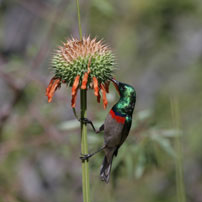 It isn’t just birds that are attracted to the water, but people too. As the lagoon extends towards the ocean you arrive in the town of Langebaan, not only the best base for visiting the park with a stay at the Farmhouse Hotel, but a renowned base for kite surfing and kayaking. A hop, skip and jump up the coast and I arrived in Paternoster, a picturesque village known for its white-washed buildings and colourful wooden fishing boats and one of the oldest settlements on the west coast. Fishing has long been the main source of employment and income here; crayfish is still caught on a commercial level whilst the subsistence fishermen catch herring and forage on the rocks for mussels. Needless to say, the sea’s bounty makes its way onto the menus and is a highlight of a stay in the area.
It isn’t just birds that are attracted to the water, but people too. As the lagoon extends towards the ocean you arrive in the town of Langebaan, not only the best base for visiting the park with a stay at the Farmhouse Hotel, but a renowned base for kite surfing and kayaking. A hop, skip and jump up the coast and I arrived in Paternoster, a picturesque village known for its white-washed buildings and colourful wooden fishing boats and one of the oldest settlements on the west coast. Fishing has long been the main source of employment and income here; crayfish is still caught on a commercial level whilst the subsistence fishermen catch herring and forage on the rocks for mussels. Needless to say, the sea’s bounty makes its way onto the menus and is a highlight of a stay in the area.
After my overnight stay at the contemporary-styled Strandloper Ocean Boutique Hotel I was up with the larks for an early morning walk on the beach. The sun had just peaked over the horizon when I left the hotel and the beach was streaked with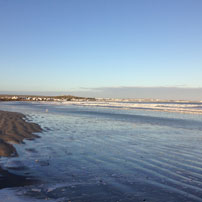 golden rays, boding well for another day of cloudless skies. Turn right when you leave the hotel and the beach stretches for miles with not one building in sight. As I set out it was just me and one solitary gull who was seemingly impervious to the chilly waters as it paddled contentedly in the shallows. As the morning warmed up I was joined by joggers and dog walkers all taking advantage of ocean views.
golden rays, boding well for another day of cloudless skies. Turn right when you leave the hotel and the beach stretches for miles with not one building in sight. As I set out it was just me and one solitary gull who was seemingly impervious to the chilly waters as it paddled contentedly in the shallows. As the morning warmed up I was joined by joggers and dog walkers all taking advantage of ocean views.
A stay in Paternoster can either be viewed as a welcome break for some R&R or as a base for some further adventure with options on land and water. Hiking, mountain biking, beach buggy rides and horse riding along spectacular trails are all possible within easy reach of Paternoster whilst water lovers can sea kayak out to penguin colonies, try their hand at fishing or from July to December head out on the waters for whale and dolphin watching.
As you leave the coastline behind you, the landscape takes on a vastly different persona as 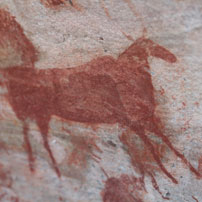 you approach the dramatic Cederberg Mountains. Dotted with incredible sandstone formations, some of which seem to teeter at impossible angles, these mountains were the ancient home of the bushman tribes who recorded details on their daily lives on cave walls and on overhanging rocks. Today some superb examples of this rock art are to be found at Bushmans Kloof, an upmarket retreat tucked away in the mountains were one can explore over 130 different sites of bushman art and gain an insight into their culture at the heritage centre.
you approach the dramatic Cederberg Mountains. Dotted with incredible sandstone formations, some of which seem to teeter at impossible angles, these mountains were the ancient home of the bushman tribes who recorded details on their daily lives on cave walls and on overhanging rocks. Today some superb examples of this rock art are to be found at Bushmans Kloof, an upmarket retreat tucked away in the mountains were one can explore over 130 different sites of bushman art and gain an insight into their culture at the heritage centre.
Rock art aside, Bushmans offers luxury accommodation, great views and a range of outdoor activities. Marked hiking trails, which can be followed alone or with a guide, leading to spectacular views whilst mountain biking in mountainous terrain and on sandy tracks offers an excellent work out!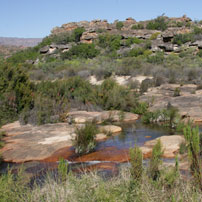
In just a few days I travelled through extensive farmlands and fertile valleys, wandered along empty beaches and drove through scenic mountain passes in the Cederberg Mountains, and all of this is within an easy drive of Cape Town.
There are several ways of including these areas in your travels; in combination as a standalone self- drive trip, as stopping off points on a longer adventure as you head north and cross into Namibia or by making good use of excellent flight connections from Cape Town to big game safari destinations.
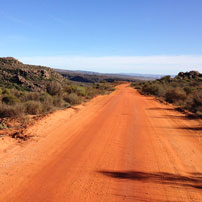 However they are built into an itinerary, it is definitely worth the effort of heading slightly off the beaten track and experiencing a part of South Africa that is often overlooked.
However they are built into an itinerary, it is definitely worth the effort of heading slightly off the beaten track and experiencing a part of South Africa that is often overlooked.
